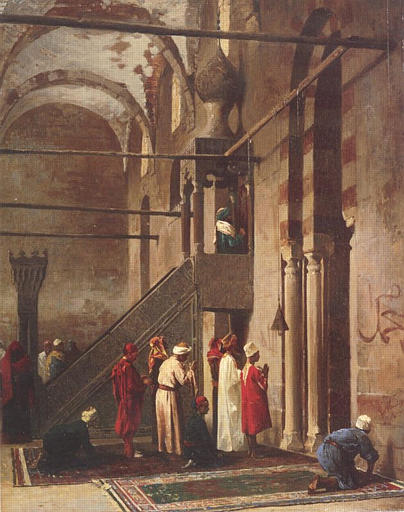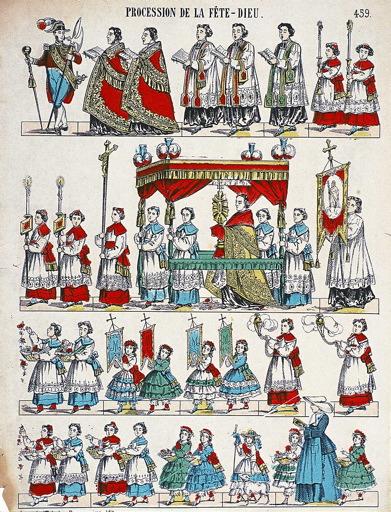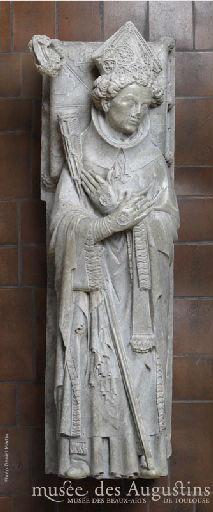Environ 40 résultats pour « Chasuble »
-

Chasuble
La chasuble est un vêtement sacerdotal à deux pans et sans manche avec une ouverture pour la tête, que le prêtre revêt par dessus l'aube et l'étole pour célébrer la messe, et pour d'autres actions liturgiques quand elles précèdent ou suivent immédiatement la messe.
-

SAINT FRANCOIS REGIS. / DE LA COMPAGNIE DE JESUS (titre ins…
-
- Domaine(s) :
- Estampe
- Ethnologie
-
- Sujet représenté :
- Auréole (religion)
- Chasuble
- Ciel
- Compagnie de Jésus
- Crucifix
- Gloire (ornement)
- …
-
- Datation :
- XIXe siècle
-
-

CANTIQUEs SPIRITUELs. / SAINT CLAUDE. / ARCHEVEQUE DE BESAN…
-
- Domaine(s) :
- Estampe
- Ethnologie
-
- Sujet représenté :
- Archevêque
- Chasuble
- Ciel
- Crosse épiscopale
- Enfant
- Gloire (ornement)
- …
-
- Datation :
- XIXe siècle
-
-

CANTIQUEs SPIRITUELs. / SAINT VINCENT. / PATRON DES VIGNERO…
-
- Domaine(s) :
- Estampe
- Ethnologie
-
- Datation :
- XIXe siècle
-
-

-

-
- Artiste(s) :
- Anonyme
La Mort de saint Benoît
-
- Domaine(s) :
- Croyance
- Ethnologie
- Ivoire
-
- Sujet représenté :
- Benoît de Nursie
- Bénédiction
- Chasuble
- Gloire (ornement)
- Prêtre catholique
- Tombeau (architecture)
-
- Datation :
- XIXe siècle
-
-

Evêque martyr
-
- Domaine(s) :
- Ethnologie
- Moyen Âge
- Orfèvrerie
-
- Sujet représenté :
- Chasuble
- Crosse épiscopale
- Dalmatique
- Feuille de palmier
- Mitre
- Évêque
-
- Datation :
- XIVe siècle
-
-

Neuf personnages
-
- Domaine(s) :
- Dessin
- Ethnologie
-
- Sujet représenté :
- Bouclier (arme)
- Casque
- Chapeau
- Chasuble
- Châle
- Costume traditionnel
- …
-
- Datation :
- XIXe siècle
- XXe siècle
-
-

LA RENCONTRE D'ABRAHAM ET DE MELCHISEDECH
-
- Domaine(s) :
- Peinture
-
- Sujet représenté :
- Autel (religion)
- Chapeau
- Chasuble
- Cheval
- Melchisédech
- Militaire
- …
-
- Datation :
- XVIIe siècle
-
-

-

-
- Artiste(s) :
- Anonyme
Dalle funéraire de Pierre d'Epfig
-
- Domaine(s) :
- Architecture
- Moyen Âge
- Sculpture
-
- Sujet représenté :
- Calice (liturgie)
- Chasuble
- Prêtre catholique
- Tunique
-
- Datation :
- XVe siècle
-
-

-
- Artiste(s) :
- Anonyme
Portrait d'un prêtre de profil, en robe noire avec chasuble…
-
- Domaine(s) :
- Dessin
-
- Sujet représenté :
- Chasuble
- Homme
- Prêtre catholique
-
-

Procession de la Vierge (titre factice)
-
- Domaine(s) :
- Estampe
- Ethnologie
-
- Sujet représenté :
- Bannière de procession
- Berger
- Chasuble
- Cierge (bougie)
- Crucifix
- Encensoir
- …
-
- Datation :
- XIXe siècle
-
-

-
- Artiste(s) :
- Anonyme
Portrait de l'Abbé Quinot (Hugues Philippe)
-
- Domaine(s) :
- Peinture
-
- Sujet représenté :
- Chasuble
- Crosse épiscopale
- Crucifix
- Mitre
- Portrait
-
- Datation :
- XVIIIe siècle
-
-

-

-
- Artiste(s) :
- Anonyme
- Pierre Paul Rubens
Saint Ignace de Loyola et Saint François-Xavier considérant…
-
- Domaine(s) :
- Asie de l'Est
- Céramique
- Ethnologie
-
- Sujet représenté :
- Autel (religion)
- Bénédiction
- Chasuble
- Fleur
- IHS (religion)
- Ignace de Loyola
- …
-
- Datation :
- XVIIIe siècle
- Dynastie Qing
-
-

-
- Artiste(s) :
- Anonyme
- Pierre Paul Rubens
Saint Ignace de Loyola et Saint François-Xavier considérant…
-
- Domaine(s) :
- Asie de l'Est
- Céramique
- Ethnologie
-
- Sujet représenté :
- Autel (religion)
- Bénédiction
- Chasuble
- Fleur
- IHS (religion)
- Ignace de Loyola
- …
-
- Datation :
- XVIIIe siècle
- Dynastie Qing
-
-

-
- Artiste(s) :
- Anonyme
Pierre tombale de Girard Blassel
-
- Sujet représenté :
- Chasuble
- Crosse épiscopale
- Crucifixion
- Jean (apôtre)
- Luc (évangéliste)
- Marc (évangéliste)
- …
-
- Datation :
- XIVe siècle
-
-

-
- Artiste(s) :
- Anonyme
PROCESSION DE LA FETE DIEU. N° 191. (titre inscrit)
-
- Domaine(s) :
- Estampe
-
- Sujet représenté :
- Bannière de procession
- Chasuble
- Cierge (bougie)
- Communauté religieuse
- Croix (christianisme)
- Encensoir
- …
-
- Datation :
- XIXe siècle
-
-

-
- Artiste(s) :
- Anonyme
PROCESSION DE LA FETE DIEU. N° 191. (titre inscrit)
-
- Domaine(s) :
- Estampe
-
- Sujet représenté :
- Chasuble
- Cierge (bougie)
- Communauté religieuse
- Croix (christianisme)
- Encensoir
- Femme
- …
-
- Datation :
- XIXe siècle
-
-

-
- Artiste(s) :
- Jean-Charles Pellerin
PROCESSION DE LA FETE - DIEU. 459. (titre inscrit)
-
- Domaine(s) :
- Estampe
-
- Sujet représenté :
- Bannière de procession
- Chasuble
- Cierge (bougie)
- Croix (christianisme)
- Encensoir
- Fleur
- …
-
- Datation :
- XIXe siècle
-
-

-
- Artiste(s) :
- Anonyme
- Jean-Charles Pellerin
PROCESSION DE LA FETE - DIEU. 459. (titre inscrit)
-
- Domaine(s) :
- Estampe
-
- Sujet représenté :
- Chasuble
- Cierge (bougie)
- Croix (christianisme)
- Encensoir
- Fleur
- Livre (document)
- …
-
- Datation :
- XIXe siècle
-
-

Gisant solidaire d'une dalle : Jean Tissendier (Jean Tissen…
-
- Domaine(s) :
- Sculpture
-
- Sujet représenté :
- Bijou
- Chape (catholicisme)
- Chasuble
- Cheveu
- Coquille Saint-Jacques
- Coussin
- …
-
- Datation :
- XIVe siècle
-
-

CHANOINE / ABBAYE / DE ST DENIS / XIVE SIECLE / LES COSTUME…
-
- Domaine(s) :
- Estampe
-
- Datation :
- XIXe siècle
- XXe siècle
-
-

-
- Artiste(s) :
- Anonyme
Présentation des Tables de la Loi (titre factice, d'après l…
-
- Domaine(s) :
- Peinture
-
- Sujet représenté :
- Allégorie
- Bâton
- Chasuble
- Christianisme
- Crosse épiscopale
- Encensoir
-
-

-
- Artiste(s) :
- Anonyme
St. EUGENE N°1190. (titre inscrit fr., it., angl.)
-
- Domaine(s) :
- Estampe
-
- Sujet représenté :
- Auréole (religion)
- Chasuble
- Crosse épiscopale
- Mitre
- Évêque
-
- Datation :
- XIXe siècle
-
-

-
- Artiste(s) :
- Anonyme
Saint Rémi
-
- Sujet représenté :
- Chasuble
- Dalmatique
- Fleur de lys
- Mitre
- Rose (fleur)
-
- Datation :
- XVIe siècle
-
-

-
- Domaine(s) :
- Sigillographie
-
- Désignation :
- sceau
-
- Sujet représenté :
- Chasuble
- Colonne (architecture)
- Lion
-
- Datation :
- XIIIe siècle
-
-

-
- Artiste(s) :
- Emmanuel Hannaux
Dupont des Loges
-


